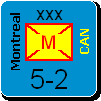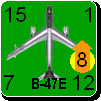warspite1
Posts: 41353
Joined: 2/2/2008
From: England
Status: offline

|
Please see attached the write-up of the encounter at Mers-el-Kebir. I would welcome comments on this episode (on reflection I may amend the British version, but will await any comment on this draft version first).
[4884 Bretagne - by Robert Jenkins]
.B Engine(s) output: 29,000 hp.
.B Top Speed: 20 knots.
.B Main armament: 10 x 13.4-inch (340mm), 22 x 5.4-inch (139mm) guns.
.B Displacement (full load): 25,000 tons
.B Thickest armour: 10.6-inch (belt)
.P The Bretagne`s were three battleships built between 1912 and 1915 and all
three ships of the class saw service in World War I. Their design was based upon
the earlier Courbet-class but with a heavier weapons package.
.P The class were extensively modernised between the wars. The range of their
main armament was improved by increasing the elevation, and a
basic anti-aircraft defence was also added. Internally, improvements were made to
the propulsion system, with an oil fired system added to the existing coal fired
arrangement. The internal protection also received treatment.
.P However, even with these improvements made, the Bretagne`s could not be
considered front-line warships at the start of World War II. Their limited
service records reflect this.
.P Bretagne was completed in September 1915. She began the Second World War
based at Toulon in the Mediterranean.
.P In December 1939, she sailed from Dakar as the French undertook two large
patrols to track down German blockade-runners (see Provence). During March and
April, Bretagne and the cruiser Algerie, escorted by three destroyers, were used
to transfer French Gold reserves from Toulon to Canada.
.P Then, at the end of April, Bretagne was transferred to Alexandria, Egypt and
shared this home with the British Mediterranean Fleet. However her stay was brief
and she was ordered to Mers-el-Kebir, Algeria a month later. At the time of the
Italian declaration of war on the 10th June 1940, in addition to Bretagne, the
French Fleet at Mers-el-Kebir consisted of the fast battleships Dunkerque and
Strasbourg; the elderly battleship Provence, the heavy cruisers Algerie, Foch,
Colbert and Dupleix; the light cruisers La Galissonniere, Jean de Vienne, Gloire,
Marseillaise, Montcalm and Georges Leygues; thirty-seven destroyers, six torpedo
boats and thirty-six submarines.
.P Over the course of the next couple of weeks the composition of the force at
this naval base stayed roughly the same, although, by the start of July, the
light cruisers named above were stationed at Algiers and the heavy cruisers were
at Toulon. Also at Mers-el-Kebir were seven destroyers.
.P At the beginning of July, just over a week after the signing of the armistice,
the French Navy were based at a number of ports, not only in France and her
overseas territories, but also in the United Kingdom and the British
Mediterranean Fleet base at Alexandria (see Paris).
.P Following the signing of the armistice between France and Germany, the British
feared that the French fleet would be seized by the Germans. Indeed, when the
French Government had originally asked their British counterparts for permission
to begin unilateral negotiations for surrender, the British Prime Minister
Winston Churchill had agreed only subject to the French Fleet sailing for British
ports immediately.
.P This did not happen and the armistice was signed. However, Admiral Darlan,
the Commander-in-Chief of the French Fleet (who was also the Minister of Marine
in the new Vichy Government) had given a promise to Churchill that French ships
would never be allowed to fall into German hands. Importantly too, a German
stipulation that the fleet was to be dis-armed under German and Italian control,
was removed from the armistice terms at the insistence of the French. Darlan had
twice issued orders to his captains to ensure that all ships were ready to be
scuttled should the Germans seek to break the agreement.
.P From their point of view, the French Navy had fought well in the few actions
that it had been a part of; Norway and France were examples of this. Also, unlike
the French Army, the navy had not collapsed before the enemy. In July 1940, this
was still a proud service.
.P It is unlikely that Churchill, a true Francophile, doubted Darlan, but he was
not convinced that the Germans would necessarily keep to their agreement, and
would seize the French ships by force at a later date. After all, the Germans had
"form" in this regard.... With Britain standing alone against the Axis, Churchill
decided that he must remove even the slightest possibility of the Axis getting
hold of the French warships one way or another; even if that meant fighting with
their former allies.
.P The British operation to deal with the French Navy was called Catapult. The
most important component of Catapult was the encounter at Mers-el-Kebir, due to
the presence there of Dunkerque and Strasbourg. The British ordered their newly
formed troubleshooting force, Force H, to sail to Algeria and on the 3rd July, an
ultimatum was delivered to Admiral Gensoul. Gensoul was given four choices; the
French could a) sail with the British and continue the war, b) sail with reduced
crews under British control to a British port, c) sail with reduced crews to a
French port in the West Indies where they would be demilitarised, or d) sail to
the (then neutral) United States. If none of these options were chosen, the
British would open fire.
.P The commander of Force H was Vice-Admiral Somerville. Things got off to a bad
start when Somerville did not present the ultimatum personally. This was left to
a French speaking junior officer. Gensoul therefore sent one of his subordinates
to meet the British in response to what he saw as an affront, before seeking
orders from Darlan. Strangely, in relaying the message to Darlan, some of the
options appear not to have been relayed. Whether this would have made any
difference will never be known.
.P With no affirmative response coming, and aware that the French may send
reinforcements from Toulon, Churchill reluctantly gave Somerville the order to
begin the operation. Just before 1800hrs, shells from the 15-inch guns began to
rain down on the French, who had little freedom of manoeuvre in the harbour. A
magazine was penetrated aboard Bretagne resulting in a huge explosion. She soon
sank, taking 977 of her crew with her. This loss was followed by hits against the
Provence, Dunkerque and the destroyer Mogador; all being severely damaged. The
Strasbourg managed to escape from the harbour with a four-strong destroyer escort
however. Although they were attacked by Swordfish from the Ark Royal, they were
able to get out to open sea and then back to Toulon. Two British cruisers engaged
one of the French destroyers, but the pursuit of the French ships was ended at
2020hrs.
.P Two days later, Swordfish from Ark Royal again attacked Mers-el-Kebir in
order to finish off the Dunkerque. A torpedo struck a patrol boat moored
alongside the battlecruiser, and when a number of depth charges were ignited,
the patrol boat blew up and the Dunkerque was further damaged. In retaliation,
the French attacked Gibraltar using aircraft from North Africa, but no real
damage was inflicted. In this tragic episode, a total of 1,297 French sailors
were killed and about 350 were wounded.
.P History records that when the Germans occupied Vichy in November 1942, the
French ships were scuttled by their crews just as Darlan had previously ordered.
The history books also show that the war in the Mediterranean was a close run
thing for the Royal Navy. What if the French ships had been captured and the
British expelled from the Mediterranean?
.P Whatever the rights and wrongs, the fact is that the death of so many sailors
at the hands of their former allies was one of the tragic moments of the Second
World War.
< Message edited by warspite1 -- 8/3/2009 8:06:50 PM >
_____________________________
England expects that every man will do his duty. Horatio Nelson October 1805  |
 Printable Version
Printable Version










 - is why was Antietam acceptable as a name and none of the other civil war battles?
- is why was Antietam acceptable as a name and none of the other civil war battles? 






 ) :
) : 







 New Messages
New Messages No New Messages
No New Messages Hot Topic w/ New Messages
Hot Topic w/ New Messages Hot Topic w/o New Messages
Hot Topic w/o New Messages Locked w/ New Messages
Locked w/ New Messages Locked w/o New Messages
Locked w/o New Messages Post New Thread
Post New Thread